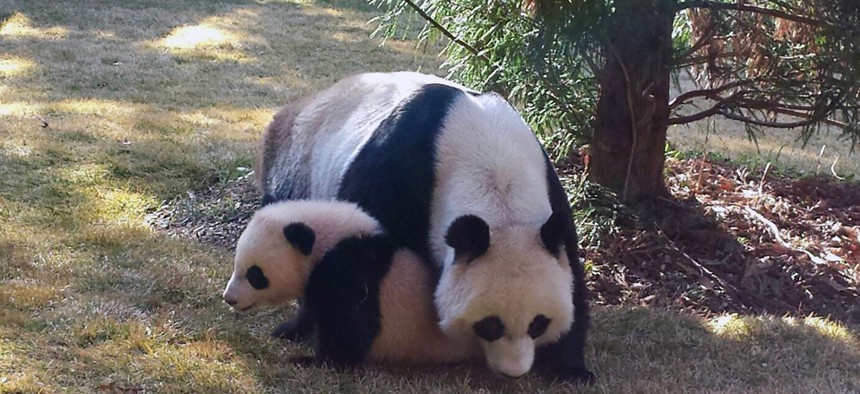
Panda cub Bao Bao enjoyed its first day outside at the National Zoo Tuesday. National Zoo photo
Why Are Baby Animals Dying at the National Zoo?
Officials say death rates haven't actually increased -- the incidents are just occurring among more popular animals.
The National Zoo has a horrifying tale to tell.
In late December, one of the zoo's sloth bears gave birth to three cubs. But then -- in a gruesome turn -- the mother ate two of her cubs within a week of their birth, forcing zookeepers to rescue the third.
The cub deaths, first made public in late March, were the latest in a string of widely publicized animal fatalities at the institution. The zoo lost two antelopes in the past year when the animals ran headlong into enclosure walls. And two of four cheetah cubs died during childbirth in April 2012 at the zoo's Conservation Biology Institute in Virginia.
The highest-profile death of all arrived a few months later, in September, when the zoo announced the birth of a baby panda -- a rare feat among the famously hesitant-to-breed bears -- only to have the infant die six days later. (The zoo has had more success since and is now home to the 7-month-old panda cub Bao Bao, which ventured outside for the time Tuesday.)
With the spate of deaths -- and given the circumstances surrounding the death of the sloth bear cubs -- one may be tempted to question if the zoo is to blame. But the truth, biologists say, is more disturbing: The natural kingdom is a rough, brutal, and fatal place, even in controlled environments like zoos, and even for species that are cute and cuddly.
"Carnivores will sometimes eat their young," Pamela Baker-Masson, a spokeswoman for the zoo, said when asked about the fate of the sloth bear cubs. "There are a lot of reasons why this might happen."
So what would possess a parent to eat its offspring?
According to National Zoo curator Tony Barthel, it all boils down to evolution. If a bear cub dies, the animal carcass left behind could attract predators. It also makes a meal. As a result, the mother may eat its young to protect itself and the rest of the litter.
"If a bear thinks its offspring is dying, it will often abandon the cub, and usually when they're young, that involves consuming them," Barthel said. "That might sound cruel but animals can't afford to needlessly waste resources. It's part of nature."
It's difficult to say how often this occurs -- either in captivity or in the wild -- because bears typically give birth in secluded areas.
The demise of the Smithsonian bear cubs -- added to other animal deaths at the zoo due to illness or injury -- have made headlines. Zoo officials, however, note that they have not had a higher than normal rate of incidents. Instead, the deaths have come among higher profile fauna.
"We have not had a spike in animal deaths," Baker-Masson said. "Deaths happen here for lots of different reasons, and many of them are due to natural causes."
And in the sad story of the sloth bear cubs, there is a silver lining.
The third cub, which zoo keepers rescued, is now receiving around-the-clock care at the institution -- a situation that has created a unique opportunity for keepers to get to know the cub.
"She's pretty rambunctious," Barthel said. "And she seems to be thriving. She's energetic and exploring more and more of her enclosure each day."
Curators plan to gradually reintroduce the cub to other bears at the zoo and hope that she can one day live on her own in captivity.
"We share everything that goes on here. There are wonderful stories and tragic ones and that can certainly draw a lot of attention to the zoo," Barthel said. "In this case you have this resilient cub but you also have this sad reality and that reminds us all how tough life in the wild can be."
NEXT STORY: How Not to Introduce a Speaker






